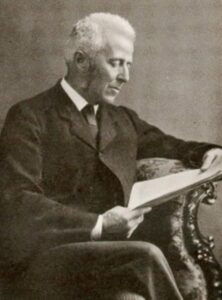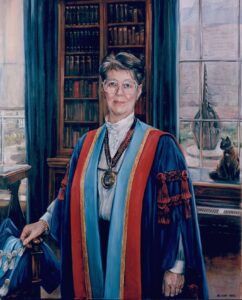20 January 2023
Steven Kerr, Librarian of RCSEd, gave us an enthusiastic and lively discourse on the history of the Royal College, and many of the important and interesting personalities associated with it.
Arising at a time when barbers cut hair, shaved beards and carried out primitive dentistry and surgery – the barber chirurgeons (surgeons) – the RCSEd is the modern name for one of the oldest surgical corporations in the world. It began life on 1 July 1505 when a Seal of Cause (a Charter of Privileges) was granted by the Town Council of Edinburgh incorporating the Barber Surgeons of Edinburgh as a Craft Guild. It conferred responsibilities upon the Guild to ensure that all members were fully knowledgeable of human anatomy, were suitably trained in the surgical craft, and were conversant with Latin. This involved apprenticeships and examination by established masters of surgery. James IV, very much a Renaissance Man who had an interest in and, indeed, practiced, a little dentistry and surgery, ratified the Seal of Cause with a Royal Charter in October 1506. Importantly, a further Charter of Mary Queen of Scots in 1567 recognised the non-combatant role of the barber surgeons, but required they should always accompany armies into battle and treat sick or injured friend and foe alike (the “Barber Surgeons letter of exemption”).
In 1583, the Incorporation of Barber Surgeons was formally recognised by Edinburgh Town council as the premier craft guild. In due course barbering activities and surgical ones came to a parting of the ways perhaps removing the frisson generated in a barbers shop when asked ‘How much shall I take off’? Also, in 1581, minutes of the Incorporation meetings were introduced as part of the increased professionalism instigated by Gilbert Primrose the then Deacon.
Primrose was surgeon to James VI and went with him to London on his accession to the crown of England in 1603. His reputation was such that Edinburgh soon became recognised as a major centre of surgical expertise, producing surgeons of high calibre. His friend Peter Lowe was instrumental in the foundation of the Royal College of Physicians and Surgeons of Glasgow. In the passing, it should be noted that the minutes of the Edinburgh college form an unbroken record from 1581 to the present day.
Surgical experience was widened and skills enhanced on the battlefields of the 30 Years War and, later during the covenanting campaigns of the 17th century. One could then add the Jacobite campaigns, and the various wars of the 18th century culmination in the Napoleonic wars. All this contributed to the development of an increasingly scientific basis for the surgical craft and growing respect for Edinburgh’s reputation in the field. In 1722, the Barbers and Surgeons formally parted company.
In the earlier stages of its existence, meetings of the Incorporation were held in the Deacons’ houses, later in St Giles Cathedral and then rented accommodation in Dickson’s Close. In 1697 the first permanent accommodation was opened in Infirmary Street – Old Surgeons Hall. In 1778 George III granted a Royal Charter, re-incorporating the surgeons as the Royal College of Surgeons of the City of Edinburgh. This was changed under the terms a charter issued by Queen Victoria in 1851 to the name used to the present day: Royal College of Surgeons of Edinburgh. Also in the 19th century the burgeoning College moved to new premises in Nicolson St, designed by William Henry Playfair – Surgeons Hall as we know it today.
Throughout the period of incorporation the organisation issued, by examination, surgical qualifications at Diploma, Licentiate and, eventually, Fellowship levels. Qualified surgeons would maintain membership by paying fees. Surgeons could practice without a medical degree provided they held an RCSEd qualification but, increasingly, they would add qualifications from the Royal College of Physicians of Edinburgh or be triply qualified through the additional membership of the Royal College of Physicians and Surgeons of Glasgow. Today a fully qualified surgeon at consultant level must be qualified as a doctor have passed the Fellowship examinations, and will carry the letters FRCSEd after their name.
Personalities and events associated with RCSEd are fascinating and sometimes notorious. John Rattray was a surgeon and physician in the 18th century, renowned for developing the Scottish Rules of Golf. He supported the Jacobites in 1745/6 and escaped execution for treason through the good offices of a Hanoverian judge with whom he had regularly played golf.
The 19th century was a particularly interesting time when Edinburgh was becoming a world renowned centre for the study of medicine. Charles Bell, a Fellow of the College, had served as surgeon to the army in Corunna and combined his skills as a surgeon with his artistic talent to produce striking images of the injured and sick. His vivid painting of a French soldier with tetanus showing the extreme muscular spasm of opisthotonos is renowned. Bell also described and gave his name to Bell’s Palsy.
The earlier part of the century saw the widespread activities of the ‘resurrectionists’ who robbed graves to provide surgeons with the bodies required to teach dissection. The most notorious of these were William Burke and William Hare who murdered to obtain the fresh corpses they sold to the famed surgeon Robert Knox. These were the West Port murders – 16 of them. In court, Hare turned Kings evidence and Burke was executed. Knox’s reputation was unsurprisingly badly tarnished by these events. Burke’s body was publicly dissected Alexander Munro (tertius), Professor of Anatomy at the University of Edinburgh. The result of the scandal was the 1832 Anatomy Act which introduced strict regulation the supply of bodies for dissection.
John Barclay bequeathed his substantial collection of anatomical and surgical specimens to the College, a condition of which was the construction of better accommodation for the display of the specimens, major factor leading to the removal of the Royal College to the much more spacious Playfair building. One of his students was Robert Liston who himself became a famous surgeon. In the days before anaesthesia became widely accepted Liston favoured speed in the operating theatre, to minimise the effect of shock. He was a very strong man and would typically amputate a leg within a minute, clamping the femoral artery with one hand and cutting with the other!
James Young Simpson, a Licentiate of the College and Fellow of the Royal College of Physicians of Edinburgh is well known as the man who explored the effect of chloroform (often sharing it around with friends at the dinner table) and recommended it for general anaesthesia. This became widely accepted only after Queen Victoria used it during the birth of her son Leopold.
James Syme was a skilled surgeon and a legendary teacher. He was less popular with his peers! He became surgeon to Queen Victoria.
Joseph Lister studied medicine in London and then surgery under Syme, indeed becoming his son in law. He was never a brilliant surgeon but is the man who introduced the principle of antisepsis to the operating theatre. His work led eventually to his elevation to the special category of Honorary Fellowship of the RCSEd – the only past president to receive this honour.

Joseph Bell was a brilliant surgeon and teacher who specialised in paediatric cases. One of his students was Arthur Conan Doyle, who was hugely impressed by Bell’s deductive skill. This surgeon was the principal main model for the character of Sherlock Holmes.
Until the late 19th century, women did not figure in the history of the College. However, in 1901 Elsie Inglis, a Licentiate of all three Scottish Colleges, founded her Maternity Hospital in Edinburgh. She was one of the first to overcome the huge resistance to women as surgeons and physicians, but made her reputation in WW1 by setting up the Scottish Woman’s Hospital in Serbia. The first women Fellows were Alice Hunter who did much of her work in India, and the much loved paediatric surgeon Gertrude Hertzfeld.
In the later 20th century, Michael Woodruff, who saved many lives while a prisoner of the Japanese in Changi, Singapore, studied immunosuppression and transplantation and was responsible for the first UK kidney transplant in the 1950s.

In the same decade a college journal was instituted and the Dental Council was launched. Dorothy Geddes became the first lady Fellow of Dentistry. She was Professor and Dean of Dentistry at the University of Edinburgh and became the first Honorary Fellow in dentistry.
Currently, the RCSEd membership is around 30,000 in about 100 countries world-wide, with 50% of the membership working in the UK.
To leave us with something of an enigma, Steven revealed that a document dated to 01 June 1466 exists in the College archive refers to Haddington. It has nothing to do with the barber surgeons and it is not at all clear why it is there.
Peter Ramage

You must be logged in to post a comment.